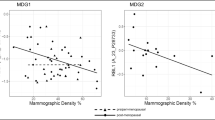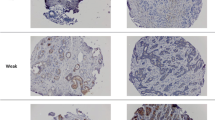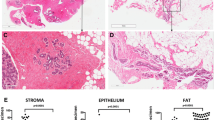Abstract
Mammographic density (MD) adjusted for age and body mass index is one of the strongest known risk factors for breast cancer. Given the high attributable risk of MD for breast cancer, chemoprevention with a safe and available agent that reduces MD and breast cancer risk would be beneficial. Cox-2 has been implicated in MD-related breast cancer risk, and was increased in stromal cells in high MD tissues in one study. Our study assessed differential Cox-2 expression in epithelial and stromal cells in paired samples of high and low MD human breast tissue, and in a validated xenograft biochamber model of MD. We also examined the effects of endocrine treatment upon Cox-2 expression in high and low MD tissues in the MD xenograft model. Paired high and low MD human breast tissue samples were immunostained for Cox-2, then assessed for differential expression and staining intensity in epithelial and stromal cells. High and low MD human breast tissues were separately maintained in biochambers in mice treated with Tamoxifen, oestrogen or placebo implants, then assessed for percentage Cox-2 staining in epithelial and stromal cells. Percentage Cox-2 staining was greater for both epithelial (p = 0.01) and stromal cells (p < 0.0001) of high compared with low MD breast tissues. In high MD biochamber tissues, percentage Cox-2 staining was greater in stromal cells of oestrogen-treated versus placebo-treated tissues (p = 0.05).







Similar content being viewed by others
References
Huo CW, Chew GL, Britt KL, Ingman WV, Henderson MA, Hopper JL, Thompson EW (2014) Mammographic density-a review on the current understanding of its association with breast cancer. Breast Cancer Res Treat 144(3):479–502. doi:10.1007/s10549-014-2901-2
McCormack VA, dos Santos Silva I (2006) Breast density and parenchymal patterns as markers of breast cancer risk: a meta-analysis. Cancer Epidemiol Biomark Prev 15(6):1159–1169. doi:10.1158/1055-9965.EPI-06-0034
Boyd NF, Martin LJ, Yaffe MJ, Minkin S (2011) Mammographic density and breast cancer risk: current understanding and future prospects. Breast Cancer Res 13(6):223. doi:10.1186/bcr2942
Baglietto L, Krishnan K, Stone J, Apicella C, Southey MC, English DR, Hopper JL, Giles GG (2014) Associations of mammographic dense and nondense areas and body mass index with risk of breast cancer. Am J Epidemiol 179(4):475–483. doi:10.1093/aje/kwt260
Mavaddat N, Pharoah PD, Michailidou K, Tyrer J, Brook MN, Bolla MK, Wang Q, Dennis J, Dunning AM, Shah M, Luben R, Brown J, Bojesen SE, Nordestgaard BG, Nielsen SF, Flyger H, Czene K, Darabi H, Eriksson M, Peto J, Dos-Santos-Silva I, Dudbridge F, Johnson N, Schmidt MK, Broeks A, Verhoef S, Rutgers EJ, Swerdlow A, Ashworth A, Orr N, Schoemaker MJ, Figueroa J, Chanock SJ, Brinton L, Lissowska J, Couch FJ, Olson JE, Vachon C, Pankratz VS, Lambrechts D, Wildiers H, Van Ongeval C, van Limbergen E, Kristensen V, Grenaker Alnaes G, Nord S, Borresen-Dale AL, Nevanlinna H, Muranen TA, Aittomaki K, Blomqvist C, Chang-Claude J, Rudolph A, Seibold P, Flesch-Janys D, Fasching PA, Haeberle L, Ekici AB, Beckmann MW, Burwinkel B, Marme F, Schneeweiss A, Sohn C, Trentham-Dietz A, Newcomb P, Titus L, Egan KM, Hunter DJ, Lindstrom S, Tamimi RM, Kraft P, Rahman N, Turnbull C, Renwick A, Seal S, Li J, Liu J, Humphreys K, Benitez J, Pilar Zamora M, Arias Perez JI, Menendez P, Jakubowska A, Lubinski J, Jaworska-Bieniek K, Durda K, Bogdanova NV, Antonenkova NN, Dork T, Anton-Culver H, Neuhausen SL, Ziogas A, Bernstein L, Devilee P, Tollenaar RA, Seynaeve C, van Asperen CJ, Cox A, Cross SS, Reed MW, Khusnutdinova E, Bermisheva M, Prokofyeva D, Takhirova Z, Meindl A, Schmutzler RK, Sutter C, Yang R, Schurmann P, Bremer M, Christiansen H, Park-Simon TW, Hillemanns P, Guenel P, Truong T, Menegaux F, Sanchez M, Radice P, Peterlongo P, Manoukian S, Pensotti V, Hopper JL, Tsimiklis H, Apicella C, Southey MC, Brauch H, Bruning T, Ko YD, Sigurdson AJ, Doody MM, Hamann U, Torres D, Ulmer HU, Forsti A, Sawyer EJ, Tomlinson I, Kerin MJ, Miller N, Andrulis IL, Knight JA, Glendon G, Marie Mulligan A, Chenevix-Trench G, Balleine R, Giles GG, Milne RL, McLean C, Lindblom A, Margolin S, Haiman CA, Henderson BE, Schumacher F, Le Marchand L, Eilber U, Wang-Gohrke S, Hooning MJ, Hollestelle A, van den Ouweland AM, Koppert LB, Carpenter J, Clarke C, Scott R, Mannermaa A, Kataja V, Kosma VM, Hartikainen JM, Brenner H, Arndt V, Stegmaier C, Karina Dieffenbach A, Winqvist R, Pylkas K, Jukkola-Vuorinen A, Grip M, Offit K, Vijai J, Robson M, Rau-Murthy R, Dwek M, Swann R, Annie Perkins K, Goldberg MS, Labreche F, Dumont M, Eccles DM, Tapper WJ, Rafiq S, John EM, Whittemore AS, Slager S, Yannoukakos D, Toland AE, Yao S, Zheng W, Halverson SL, Gonzalez-Neira A, Pita G, Rosario Alonso M, Alvarez N, Herrero D, Tessier DC, Vincent D, Bacot F, Luccarini C, Baynes C, Ahmed S, Maranian M, Healey CS, Simard J, Hall P, Easton DF, Garcia-Closas M (2015) Prediction of breast cancer risk based on profiling with common genetic variants. J Natl Cancer Inst 107(5):djv036. doi:10.1093/jnci/djv036
Hopper JL (2015) Odds PER Adjusted standard deviation (OPERA): comparing strengths of associations for risk factors measured on different scales, and across diseases and populations. Am J Epidemiol. doi:10.1093/aje/kwv193
Ghosh K, Brandt KR, Reynolds C, Scott CG, Pankratz VS, Riehle DL, Lingle WL, Odogwu T, Radisky DC, Visscher DW, Ingle JN, Hartmann LC, Vachon CM (2012) Tissue composition of mammographically dense and non-dense breast tissue. Breast Cancer Res Treat 131(1):267–275. doi:10.1007/s10549-011-1727-4
Lin SJ, Cawson J, Hill P, Haviv I, Jenkins M, Hopper JL, Southey MC, Campbell IG, Thompson EW (2011) Image-guided sampling reveals increased stroma and lower glandular complexity in mammographically dense breast tissue. Breast Cancer Res Treat 128(2):505–516. doi:10.1007/s10549-011-1346-0
Li T, Sun L, Miller N, Nicklee T, Woo J, Hulse-Smith L, Tsao MS, Khokha R, Martin L, Boyd N (2005) The association of measured breast tissue characteristics with mammographic density and other risk factors for breast cancer. Cancer Epidemiol Biomark Prev 14(2):343–349. doi:10.1158/1055-9965.EPI-04-0490
Huo CW, Chew G, Hill P, Huang D, Ingman W, Hodson L, Brown KA, Magenau A, Allam AH, McGhee E, Timpson P, Henderson MA, Thompson EW, Britt K (2015) High mammographic density is associated with an increase in stromal collagen and immune cells within the mammary epithelium. Breast Cancer Res 17(1):79. doi:10.1186/s13058-015-0592-1
Provenzano PP, Inman DR, Eliceiri KW, Knittel JG, Yan L, Rueden CT, White JG, Keely PJ (2008) Collagen density promotes mammary tumor initiation and progression. BMC Med 6:11. doi:10.1186/1741-7015-6-11
Ashok V, Dash C, Rohan TE, Sprafka JM, Terry PD (2011) Selective cyclooxygenase-2 (COX-2) inhibitors and breast cancer risk. Breast 20(1):66–70. doi:10.1016/j.breast.2010.07.004
Cuzick J, Warwick J, Pinney E, Duffy SW, Cawthorn S, Howell A, Forbes JF, Warren RM (2011) Tamoxifen-induced reduction in mammographic density and breast cancer risk reduction: a nested case-control study. J Natl Cancer Inst 103(9):744–752. doi:10.1093/jnci/djr079
Soslow RA, Dannenberg AJ, Rush D, Woerner BM, Khan KN, Masferrer J, Koki AT (2000) COX-2 is expressed in human pulmonary, colonic, and mammary tumors. Cancer 89(12):2637–2645
Ristimaki A, Sivula A, Lundin J, Lundin M, Salminen T, Haglund C, Joensuu H, Isola J (2002) Prognostic significance of elevated cyclooxygenase-2 expression in breast cancer. Cancer Res 62(3):632–635
Half E, Tang XM, Gwyn K, Sahin A, Wathen K, Sinicrope FA (2002) Cyclooxygenase-2 expression in human breast cancers and adjacent ductal carcinoma in situ. Cancer Res 62(6):1676–1681
Subbaramaiah K, Norton L, Gerald W, Dannenberg AJ (2002) Cyclooxygenase-2 is overexpressed in HER-2/neu-positive breast cancer: evidence for involvement of AP-1 and PEA3. J Biol Chem 277(21):18649–18657. doi:10.1074/jbc.M111415200
Spizzo G, Gastl G, Wolf D, Gunsilius E, Steurer M, Fong D, Amberger A, Margreiter R, Obrist P (2003) Correlation of COX-2 and Ep-CAM overexpression in human invasive breast cancer and its impact on survival. Br J Cancer 88(4):574–578. doi:10.1038/sj.bjc.6600741
Yang WT, Lewis MT, Hess K, Wong H, Tsimelzon A, Karadag N, Cairo M, Wei C, Meric-Bernstam F, Brown P, Arun B, Hortobagyi GN, Sahin A, Chang JC (2010) Decreased TGFbeta signaling and increased COX2 expression in high risk women with increased mammographic breast density. Breast Cancer Res Treat 119(2):305–314. doi:10.1007/s10549-009-0350-0
Chew GL, Huang D, Lin SJ, Huo C, Blick T, Henderson MA, Hill P, Cawson J, Morrison WA, Campbell IG, Hopper JL, Southey MC, Haviv I, Thompson EW (2012) High and low mammographic density human breast tissues maintain histological differential in murine tissue engineering chambers. Breast Cancer Res Treat 135(1):177–187. doi:10.1007/s10549-012-2128-z
Chew GL, Huang D, Huo CW, Blick T, Hill P, Cawson J, Frazer H, Southey MC, Hopper J, Henderson M, Haviv I, Thompson EW (2013) Dynamic changes in high and low mammographic density human breast tissues maintained in murine tissue engineering chambers during various murine peripartum states and over time. Breast Cancer Res Treat 140:285–297
Chew GL, Huo CW, Huang D, Blick T, Hill P, Cawson J, Frazer H, Southey MC, Hopper JL, Britt K, Henderson MA, Haviv I, Thompson EW (2014) Effects of Tamoxifen and oestrogen on histology and radiographic density in high and low mammographic density human breast tissues maintained in murine tissue engineering chambers. Breast Cancer Res Treat 148(2):303–314. doi:10.1007/s10549-014-3169-2
BI-RADS (2003) BI-RADS. American College of Radiology, Reston
Arteaga CL, Koli KM, Dugger TC, Clarke R (1999) Reversal of tamoxifen resistance of human breast carcinomas in vivo by neutralizing antibodies to transforming growth factor-beta. J Natl Cancer Inst 91(1):46–53
Davies G, Salter J, Hills M, Martin LA, Sacks N, Dowsett M (2003) Correlation between cyclooxygenase-2 expression and angiogenesis in human breast cancer. Clin Cancer Res 9(7):2651–2656
Costa C, Soares R, Reis-Filho JS, Leitao D, Amendoeira I, Schmitt FC (2002) Cyclo-oxygenase 2 expression is associated with angiogenesis and lymph node metastasis in human breast cancer. J Clin Pathol 55(6):429–434
Chang SH, Liu CH, Conway R, Han DK, Nithipatikom K, Trifan OC, Lane TF, Hla T (2004) Role of prostaglandin E2-dependent angiogenic switch in cyclooxygenase 2-induced breast cancer progression. Proc Natl Acad Sci USA 101(2):591–596. doi:10.1073/pnas.2535911100
Robertson FM, Mallery SR, Bergdall-Costell VK, Cheng M, Pei P, Prosperi JR, Ferrari M (2007) Cyclooxygenase-2 directly induces MCF-7 breast tumor cells to develop into exponentially growing, highly angiogenic and regionally invasive human ductal carcinoma xenografts. Anticancer Res 27(2):719–727
Generali D, Buffa FM, Deb S, Cummings M, Reid LE, Taylor M, Andreis D, Allevi G, Ferrero G, Byrne D, Martinotti M, Bottini A, Harris AL, Lakhani SR, Fox SB (2014) COX-2 expression is predictive for early relapse and aromatase inhibitor resistance in patients with ductal carcinoma in situ of the breast, and is a target for treatment. Br J Cancer 111(1):46–54. doi:10.1038/bjc.2014.236
Lin F, Luo J, Gao W, Wu J, Shao Z, Wang Z, Meng J, Ou Z, Yang G (2013) COX-2 promotes breast cancer cell radioresistance via p38/MAPK-mediated cellular anti-apoptosis and invasiveness. Tumour Biol 34(5):2817–2826. doi:10.1007/s13277-013-0840-x
Park BW, Park S, Park HS, Koo JS, Yang WI, Lee JS, Hwang H, Kim SI, Lee KS (2012) Cyclooxygenase-2 expression in proliferative Ki-67-positive breast cancers is associated with poor outcomes. Breast Cancer Res Treat 133(2):741–751. doi:10.1007/s10549-012-1971-2
Lyons TR, O’Brien J, Borges VF, Conklin MW, Keely PJ, Eliceiri KW, Marusyk A, Tan AC, Schedin P (2011) Postpartum mammary gland involution drives progression of ductal carcinoma in situ through collagen and COX-2. Nat Med 17(9):1109–1115. doi:10.1038/nm.2416
Hwang D, Scollard D, Byrne J, Levine E (1998) Expression of cyclooxygenase-1 and cyclooxygenase-2 in human breast cancer. J Natl Cancer Inst 90(6):455–460
Davies G, Martin LA, Sacks N, Dowsett M (2002) Cyclooxygenase-2 (COX-2), aromatase and breast cancer: a possible role for COX-2 inhibitors in breast cancer chemoprevention. Ann Oncol 13(5):669–678
Hoellen F, Kelling K, Dittmer C, Diedrich K, Friedrich M, Thill M (2011) Impact of cyclooxygenase-2 in breast cancer. Anticancer Res 31(12):4359–4367
Zhao Y, Agarwal VR, Mendelson CR, Simpson ER (1996) Estrogen biosynthesis proximal to a breast tumor is stimulated by PGE2 via cyclic AMP, leading to activation of promoter II of the CYP19 (aromatase) gene. Endocrinology 137(12):5739–5742. doi:10.1210/endo.137.12.8940410
Brueggemeier RW, Quinn AL, Parrett ML, Joarder FS, Harris RE, Robertson FM (1999) Correlation of aromatase and cyclooxygenase gene expression in human breast cancer specimens. Cancer Lett 140(1–2):27–35
Kwan ML, Habel LA, Slattery ML, Caan B (2007) NSAIDs and breast cancer recurrence in a prospective cohort study. Cancer Causes Control 18(6):613–620. doi:10.1007/s10552-007-9003-y
Holmes MD, Chen WY, Li L, Hertzmark E, Spiegelman D, Hankinson SE (2010) Aspirin intake and survival after breast cancer. J Clin Oncol 28(9):1467–1472. doi:10.1200/JCO.2009.22.7918
Khuder SA, Mutgi AB (2001) Breast cancer and NSAID use: a meta-analysis. Br J Cancer 84(9):1188–1192. doi:10.1054/bjoc.2000.1709
Cotterchio M, Kreiger N, Sloan M, Steingart A (2001) Nonsteroidal anti-inflammatory drug use and breast cancer risk. Cancer Epidemiol Biomark Prev 10(11):1213–1217
Brandao RD, Veeck J, Van de Vijver KK, Lindsey P, de Vries B, van Elssen CH, Blok MJ, Keymeulen K, Ayoubi T, Smeets HJ, Tjan-Heijnen VC, Hupperets PS (2013) A randomised controlled phase II trial of pre-operative celecoxib treatment reveals anti-tumour transcriptional response in primary breast cancer. Breast Cancer Res 15(2):R29. doi:10.1186/bcr3409
McTiernan A, Wang CY, Sorensen B, Xiao L, Buist DS, Aiello Bowles EJ, White E, Rossing MA, Potter J, Urban N (2009) No effect of aspirin on mammographic density in a randomized controlled clinical trial. Cancer Epidemiol Biomark Prev 18(5):1524–1530. doi:10.1158/1055-9965.EPI-08-1088
Stone J, Willenberg L, Apicella C, Treloar S, Hopper J (2012) The association between mammographic density measures and aspirin or other NSAID use. Breast Cancer Res Treat 132(1):259–266. doi:10.1007/s10549-011-1834-2
Maskarinec G, Urano Y, Gill J, Kolonel LN (2008) Nonsteroidal anti-inflammatory drugs (NSAIDs) and mammographic density. Breast Cancer Res Treat 112(1):133–139. doi:10.1007/s10549-007-9829-8
Terry MB, Buist DS, Trentham-Dietz A, James-Todd TM, Liao Y (2008) Nonsteroidal anti-inflammatory drugs and change in mammographic density: a cohort study using pharmacy records on over 29,000 postmenopausal women. Cancer Epidemiol Biomark Prev 17(5):1088–1095. doi:10.1158/1055-9965.EPI-07-2836
Cuzick J, DeCensi A, Arun B, Brown PH, Castiglione M, Dunn B, Forbes JF, Glaus A, Howell A, von Minckwitz G, Vogel V, Zwierzina H (2011) Preventive therapy for breast cancer: a consensus statement. Lancet Oncol 12(5):496–503. doi:10.1016/S1470-2045(11)70030-4
Li J, Humphreys K, Eriksson L, Edgren G, Czene K, Hall P (2013) Mammographic density reduction is a prognostic marker of response to adjuvant tamoxifen therapy in postmenopausal patients with breast cancer. J Clin Oncol 31(18):2249–2256. doi:10.1200/JCO.2012.44.5015
Arun B, Goss P (2004) The role of COX-2 inhibition in breast cancer treatment and prevention. Semin Oncol 31(2 Suppl 7):22–29
Acknowledgments
This work was supported by the Victorian Breast Cancer Research Consortium (EWT, JH), the St Vincent’s Hospital Research Endowment Fund (EWT, GLC), the National Health and Medical Research Council (GLC, JH) and the University of Melbourne Research Grant Support Scheme (EWT, IH, GLC). This study benefited from support by the Victorian Government’s Operational Infrastructure Support Program to St. Vincent’s Institute.
Author information
Authors and Affiliations
Corresponding author
Ethics declarations
Competing interests
The authors declare that they have no competing interests.
Additional information
K Britt and E. W. Thompson: Co-senior authors
Electronic supplementary material
Below is the link to the electronic supplementary material.
10549_2015_3520_MOESM1_ESM.pptx
Supp. Fig. 1 Sections of high MD tissues under high-power microscopy (magnification 40×), stained with H + E. The tissue sections show the histologic appearance of a epithelial cell, b stromal cell, and c an immune cell. Supplementary material 1 (PPTX 1434 kb)
Rights and permissions
About this article
Cite this article
Chew, G.L., Huo, C.W., Huang, D. et al. Increased COX-2 expression in epithelial and stromal cells of high mammographic density tissues and in a xenograft model of mammographic density. Breast Cancer Res Treat 153, 89–99 (2015). https://doi.org/10.1007/s10549-015-3520-2
Received:
Accepted:
Published:
Issue Date:
DOI: https://doi.org/10.1007/s10549-015-3520-2




